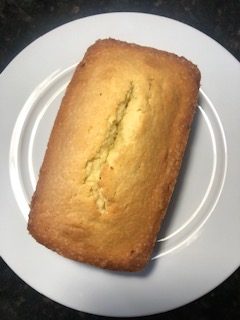

325F, or 300F convection, middle rack
1 metal loaf pan generously greased with softened butter (do NOT substitute oil in this step).
In a 5-6 quart bowl and electric mixer with paddle attachment, mix in this order using "the creaming method". Remember, an electric mixer is strongly recommended for any recipe using a solid fat (unless you have incredible stamina and strength).
-sugar and butter- paddle on low until crumbly and then increase speed to medium, mixing for about 5 minutes . Do not rush this step! If your butter is still a little too cold, this will take longer. Before you stop creaming your butter, your mixture should be almost white, very fluffy, and almost like frosting in texture and spreadability.
-eggs one at a time, and paddle on medium low until thoroughly mixed, about 2 minutes each.
-Take all dry ingredients (flour, cream of tartar, baking powder, salt) and whisk in a separate bowl for 30 seconds to combine. This might seem superfluous, but this process helps to properly suspend ingredients of different densities.
-all dry ingredients on low speed until no dry lumps remain, only 1 minute .
With a spatula, spread batter into the buttered loaf pan. It will be a thick batter, so evenly spreading the mixture will be necessary. The pan should not look completely full, and the cake will rise as it bakes (as long as you properly creamed the butter!).
Bake until middle of the pans are set, 45-50 minutes, rotating the pan after 20 minutes.
The cakes should pass the skewer test and spring back completely if lightly touched in the center. I strongly recommend rotating your pan half way through baking to ensure an even bake.
After baking, let the cake rest in the pan for 10 minutes. Run a knife along the outer edge of each pan, and carefully flip the pans over to remove the cakes onto a plate or board.
Let cool almost completely before cutting, about 40 minutes. This loaf can (and should) be served slightly warm.
Serving Size 1 loaf
Servings 0